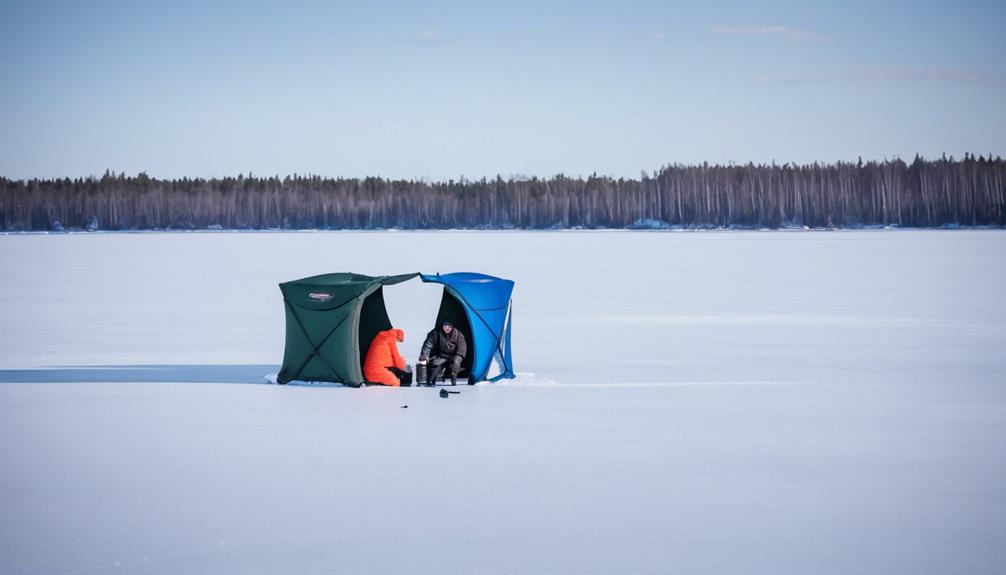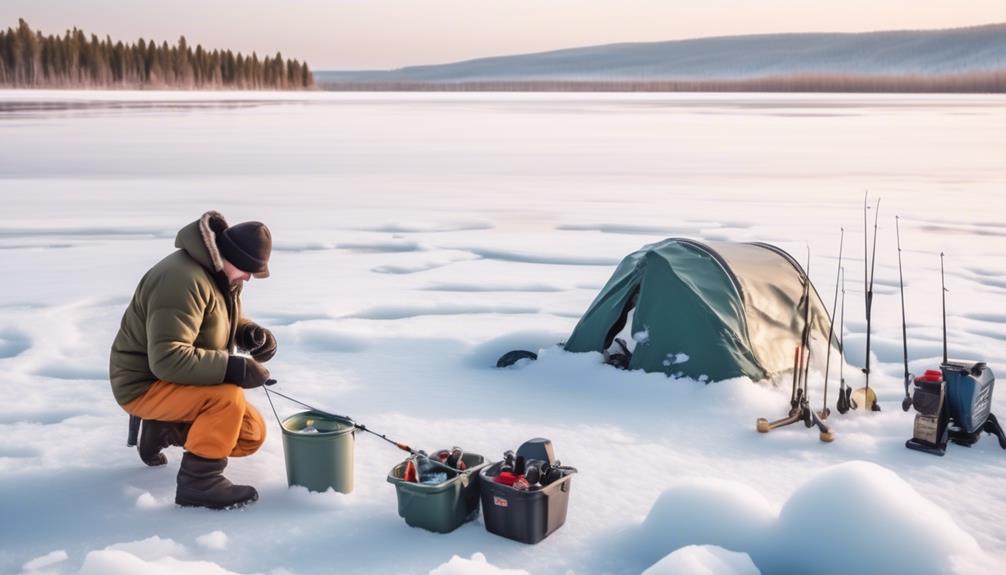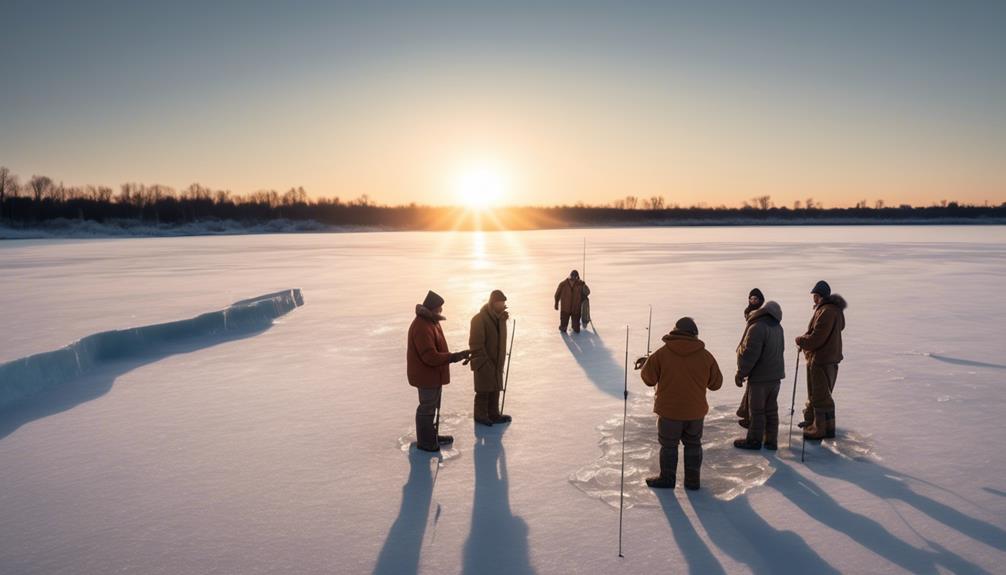As a beginner ice angler, the simple act of dropping a line through a hole in frozen water seems both thrilling and daunting. But fear not, because with the right techniques, you can turn this chilly pastime into a rewarding and enjoyable experience.
From mastering the art of jigging to understanding the nuances of tip-ups, there are numerous strategies that can greatly enhance your chances of success on the ice.
Whether you're curious about the best ways to attract fish or eager to learn how to stay safe while pursuing your catch, these 9 ice fishing techniques will set you on the path to becoming a confident and skilled angler.
Jigging
When ice fishing, the key to successful jigging is to use a light, sensitive rod combined with a small, lively bait to entice the fish. Jigging techniques play a crucial role in ice fishing success. When it comes to rod selection, opt for a rod that's both lightweight and sensitive. A sensitive rod allows you to feel even the slightest nibble, increasing your chances of hooking the fish. Additionally, a light rod reduces fatigue during long days on the ice, enabling you to jig with precision for extended periods.
When jigging for different fish species, it's essential to adapt your techniques. For example, panfish like bluegill and crappie often respond well to subtle, finesse jigging. In contrast, predatory species such as walleye and pike may prefer more aggressive jigging movements. Varying your jigging style based on the target species can significantly improve your catch rates.
Furthermore, when jigging in varying depths, it's crucial to adjust your approach. In shallow waters, fish are more likely to be spooked by heavy movements, so a gentler jigging action is often more effective. On the other hand, in deeper waters, where fish may be less easily startled, more pronounced jigging motions can attract their attention from afar.
Tip-Ups
Tip-Ups are a great tool for ice fishing, allowing you to fish multiple holes at once without actively holding a rod. They're essential for a successful ice fishing trip, but they do require some maintenance to ensure they function properly. Ensure that the flag can move freely and the spool turns smoothly. Grease any metal parts and check for any signs of wear and tear. Proper maintenance will ensure that your tip-up is ready for action when you need it.
- Tip up maintenance: Regularly check your tip-ups for any signs of damage and ensure that all moving parts are in good working condition.
- Tip up rigging: Properly rig your tip-up with the appropriate line and hook. Make sure that the line is free of tangles and the hook is baited correctly for the targeted fish species.
- Tip up placement: Strategically place your tip-ups in different locations to cover a larger area and increase your chances of catching fish. Consider the depth and structure of the water to determine the best placement for each tip-up.
When using tip-ups, always be mindful of ice fishing etiquette. Don't leave tip-ups unattended for long periods, and promptly release any unintended catches. By mastering tip-up maintenance, rigging, and placement, you can significantly enhance your ice fishing experience.
Dead Sticking
Dead sticking is a passive ice fishing technique that involves leaving a baited rod in a holder and waiting for a fish to bite. This method is great for beginners or those who prefer a more relaxed approach to fishing. One of the advantages of dead sticking is that it allows you to fish multiple holes at once, increasing your chances of catching a fish. It's also a great way to cover more area and test different depths without constantly reeling in and re-baiting your line.
However, a disadvantage of dead sticking is that it requires a lot of patience, as you may have to wait for extended periods without any action.
When it comes to different weather conditions, dead sticking can be particularly effective during cold, calm days when fish are less active. During these times, fish are more likely to take their time when approaching bait, making dead sticking a suitable technique. However, in windy or turbulent weather, dead sticking may not be as effective, as the movement of the water can cause your bait to appear unnatural. During these conditions, more active fishing techniques such as jigging or tip-ups may yield better results.
Understanding the advantages and disadvantages of dead sticking, as well as its effectiveness in different weather conditions, can help you make the most of this passive ice fishing technique.
Hole Hopping
If you're looking to keep things active and cover more ground, hole hopping is a versatile ice fishing technique that allows you to move between multiple fishing spots, increasing your chances of encountering active fish. When hole hopping, proper equipment selection is essential. You'll need a portable ice shelter, an auger for drilling holes, and a sled to transport your gear efficiently across the ice. It's important to stay aware of changing ice conditions, ensuring the safety of your movements.
Strategies for locating fish while hole hopping involve drilling multiple holes in a designated area. Utilize an electronic fish finder to identify potential hotspots beneath the ice. Once holes are drilled, managing multiple holes becomes crucial. Use tip-ups in some holes while actively jigging in others, maximizing your chances of attracting fish. Keep your gear organized and readily accessible to ensure seamless transitions between holes.
As you move from hole to hole, pay attention to subtle cues such as changes in water depth or bottom structure. By covering a larger area, you increase the likelihood of finding active fish. Remember to stay mindful of safety precautions, especially when traveling across the ice.
Hole hopping is an engaging and productive ice fishing technique that allows you to adapt to changing fish behavior and maximize your chances of success.
Sight Fishing
When sight fishing during ice fishing, it's essential to carefully observe the underwater activity to locate and target specific fish species. Underwater visibility plays a crucial role in sight fishing. Clear ice and water conditions are ideal for this technique, as they allow you to see the behavior of the fish beneath the surface. Look for areas with good underwater visibility, such as shallow, clear water or areas with natural springs.
Once you've found a promising spot, pay close attention to fish behavior. Watch for any movements, such as fish swimming near the bottom or following your bait. These cues can help you determine the type of fish present and their level of activity.
In sight fishing, staying patient and observant is key. Keep your movements to a minimum to avoid spooking the fish. Use a small, subtle jigging motion to entice the fish without scaring them away.
It's also essential to have the right equipment for this technique. Consider using a longer ice fishing rod to improve your reach and visibility into the water. Additionally, invest in quality polarized sunglasses to reduce glare and improve your ability to see underwater.
Using Electronics
Consider using sonar or fish finders to locate fish beneath the ice. Sonar usage in ice fishing has become increasingly popular, allowing you to accurately locate fish and determine their depth. By sending sound waves through the water, sonar technology can create a visual representation of the underwater environment, helping you identify potential hotspots and increase your chances of a successful catch.
With sonar, you can efficiently scan a larger area beneath the ice, identifying schools of fish and their movements. This can save you time and effort by directing you to the most promising spots.
In addition to sonar, integrating GPS navigation into your ice fishing setup can further enhance your experience. GPS devices specifically designed for ice fishing can help you navigate the frozen terrain with ease, ensuring you reach your desired fishing location without any hiccups.
Furthermore, GPS units can store and mark productive fishing spots, enabling you to return to successful locations in the future. This feature is especially useful for beginners who are still familiarizing themselves with the best fishing spots in a particular area.
Setting Up Shelters

To set up your shelter for ice fishing, start by selecting a suitable location on the ice that provides protection from the elements and offers easy access to your fishing holes. Choosing the right shelter is crucial for a successful ice fishing experience. There are various types of shelters available, including portable ice fishing shelters, flip-over shelters, and hub-style shelters. Portable ice fishing shelters are lightweight and easy to transport, while flip-over shelters provide a secure and enclosed space. Hub-style shelters are spacious and offer plenty of room for multiple anglers. Consider factors such as the number of people in your group, the duration of your fishing trip, and the prevailing weather conditions when choosing the right shelter.
Maintaining warmth and comfort is essential when ice fishing. Once you have set up your shelter, insulate the interior by laying down a thermal blanket or an insulating floor. This will help prevent the cold from seeping in and keep you warm throughout your fishing excursion. Additionally, using a portable heater inside the shelter can provide extra warmth, making your ice fishing experience more enjoyable. It's important to ensure proper ventilation when using a heater to avoid carbon monoxide build-up. Equipping your shelter with comfortable seating and organizing your gear efficiently will also contribute to a more pleasant and productive ice fishing trip.
Safety Measures
After setting up your shelter for ice fishing, prioritize safety by familiarizing yourself with essential safety measures to ensure a secure and enjoyable fishing experience on the ice.
To ensure your safety while ice fishing, keep these important safety measures in mind:
- Ice Thickness: Always check the ice thickness before venturing out. A minimum of 4 inches of clear, hard ice is generally safe for ice fishing. However, for larger groups or vehicles, the ice should be at least 8-12 inches thick. Use an ice chisel or auger to test the thickness as you move further onto the ice.
- Emergency Protocols: Familiarize yourself with emergency procedures and protocols. Carry safety equipment such as ice picks, a throw rope, and a life jacket. Additionally, inform someone about your fishing location and expected return time. Should an emergency arise, knowing how to respond can make all the difference.
Being cautious about ice thickness and being well-prepared with emergency protocols are crucial for your safety. Always remember that ice conditions can vary, so remain vigilant and prepared at all times.
Frequently Asked Questions
What Are the Best Types of Bait to Use for Ice Fishing?
You'll want to use live bait like minnows or waxworms for ice fishing. They're effective for catching a variety of fish species. Always check local regulations for bait restrictions, and remember to stay safe on the ice!
How Can I Determine the Thickness of the Ice Before I Start Fishing?
Before ice fishing, ensure ice safety. To measure ice thickness, use an ice chisel or auger to drill test holes. Measure thickness at various spots, especially near shorelines and in areas with moving water.
Are There Any Specific Regulations or Licenses Required for Ice Fishing in Certain Areas?
Before you head out for ice fishing, make sure to check the specific regulations and license requirements for the area. It's crucial for safety and to avoid any legal issues. Also, don't forget to maintain your equipment properly.
What Are Some Common Mistakes That Beginners Make When Ice Fishing?
When ice fishing, common mistakes include lack of proper preparation and neglecting safety tips. Keep in mind equipment maintenance to avoid issues. Stay safe by being aware of ice conditions and dressing warmly.
How Do I Properly Dress for the Cold Weather When Ice Fishing?
When ice fishing, layering is key to staying warm. Start with a moisture-wicking base layer, add an insulating layer, and top it off with a waterproof and windproof outer layer. Don't forget good quality cold weather gear.
Conclusion
So, whether you're a beginner or experienced angler, these ice fishing techniques will help you have a successful and enjoyable time on the ice.
Remember to stay safe, use the right equipment, and be patient.
With practice and experience, you'll become a skilled ice fisherman in no time.
Good luck and tight lines!



